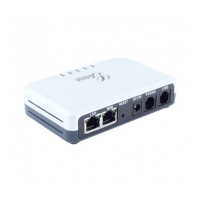the far end volume using the TX Gain Level parameter under the FXO Port
Configuration page.
Enable Current
Disconnect
Default is Yes. This value should be used in case the PSTN provider uses
line power drop to indicate call completion to the end point. In this case the
HT503 will search for a power drop for a preconfigured time frame to
disconnect such calls from a VoIP extension.
Current Disconnect
Threshold (ms)
This is a preconfigured value of duration for a line power drop used by
specific service providers. For example, for a configured value of 500ms
the device will ignore any random voltage drops on the line if duration of
such drop is less than 500ms and the call will NOT be considered as
terminated. This is useful to prevent unnecessary call drops in some low
quality PSTN lines.
Enable PSTN
Disconnect Tone
Detection
If set to Yes, arrived Busy Tone is used as the disconnect signal.
In certain countries, the central office will send a special busy tone to
indicate when a call is disconnected from the remote side. User can pre-
configure this tone on the ATA. The user should know the frequency values
and cadences of these tones.
Here is an example for the syntax for a busy tone in the U.S.A:
(Syntax: f1=freq@vol, f2=freq@vol, c=on1/off1-on2/off2-on3/off3;)
(Note: freq: 0 - 4000Hz; vol: -30 - 0dBm)
(Default: Busy Tone - f1=480@-24,f2=620@-24,c=500/500;)
Note : Maximum supported cadences is 3
You can select the AC termination by Country or by Impedance.
15 Countries are selectable in this version of the F/W.
Select the Impedance used by the PSTN service provider.
Default is 4. This setting specifies number of phone rings (on the phone
connected to the FXS port) before a PSTN incoming call is bridged to VoIP
Note: The number of rings feature serves as a PSTN answer delay, and
should be set to a larger value to allow enough time for the HT503 to
decode the Caller ID signal set by the central office.

